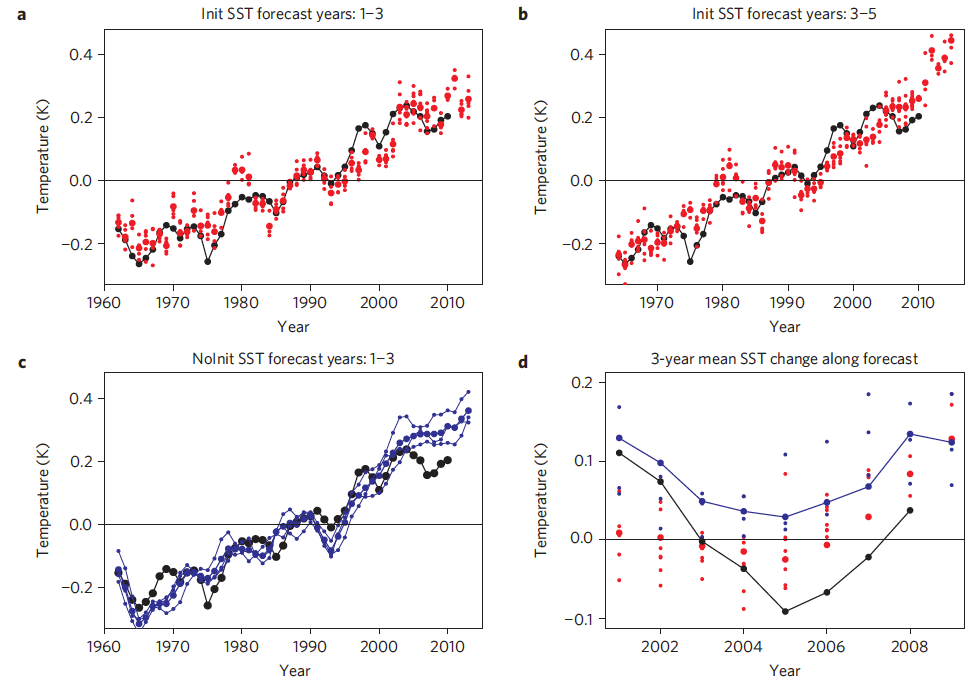
Recently we discussed a paper by Balmaseda et al., which found that the warming of the world's oceans has accelerated, and the heat accumulation in the oceans since 1999 is the most sustained warming period on record (over the past 50 years). That unprecedented warming of oceans may help explain the slowed warming of surface temperatures over the past 10–15 years.
Another new paper published in Nature Climate Change by Guemas et al. (2013) specifically attempts to explain that recent slowed global surface warming. The study concludes that most of the slowed surface warming can be attributed to the increased accumulation of heat in the oceans.
The authors use the EC-Earth climate model and run an experiment in which the initial conditions are based on reconstructions of past climate changes. Those reconstructions come from reanalysis data. A ‘reanalysis’ is a climate or weather model simulation of the past that incorporates data from historical observations. For the ocean component, they use the same European Centre for Medium-Range Weather Forecasts' Ocean Reanalysis System 4 (ORAS4) as was used in the Balmaseda paper. For the atmosphere and land component, they use the ERA40 and ERAinterim projects.
Guemas et al. compared the short-term predictive ability of the initialized model simulations to simulations without any information about the previous history of the observed climate variability. In both cases, the model runs were based on the observed radiative forcings (global energy imbalances caused by factors like the increased greenhouse effect). The question was whether accounting for past natural variability would allow the model to more accurately predict short-term future changes.
The main results are shown in the figures below. Figures 1a and 1b show the initialized model simulation (Init) 1–3 and 3–5 year forecasts (red) compared to observational data (black). Figure 1c shows the model experiment which did not include any past natural variability observations (blue) compared to the data (black). The initialized model simulations in red were able to much more accurately forecast the slowed sea surface temperature (SST) changes than the uninitialized control run (NoInit).
Figure 1: Ability to capture the warming slowdown. a–c, Global SST anomalies averaged between 60°S and 65°N and across forecast years 1–3 (a,c) and forecast years 3–5 (b). d, 3-year mean SST change along the forecasts. One large dot is shown for the ensemble mean of each forecast and small dots are shown for their members in Init (red). The equivalents in NoInit and in the observations are shown in blue and black respectively, joined by lines as they come from a continuous time series.
Similarly, they were able to much more accurately forecast ocean heat content (OHC) changes when past natural variability was incorporated into the model simulations (Figure 2).
Figure 2: Ability to predict the ocean heat storage. a–c, Total global OHC anomalies averaged across forecast years 1–3 (a,c) and forecast years 3–5 (b). d, 3-year accumulated heat uptake along the forecasts. One large dot is shown for the ensemble mean of each forecast and small dots are shown for their members in Init (red). The equivalents in NoInit and in the ORAS4 reanalysis are shown in blue and black respectively, joined by lines as they come from a continuous time series.
Interestingly, Guemas et al. find that most of the recent slowed surface warming can be attributed not to the accelerated deep ocean warming, but to the accumulation of heat in the relatively shallow oceans (to 700 meters). They note that their results are consistent with Loeb (2012), in that most of the global energy imbalance is absorbed by the upper 700 meters of oceans, although the deeper ocean heat accumulation cannot be neglected. The authors conclude,
"Most of this excess energy was absorbed in the top 700m of the ocean at the onset of the warming pause, 65% of it in the tropical Pacific and Atlantic oceans. Our results hence point at the key role of the ocean heat uptake in the recent warming slowdown."
Guemas et al. (2013) adds to the growing body of evidence that the slowed global surface warming over the past 10–15 years can in large part be explained by an increase in ocean heat storage. In short, global warming continues, it's just mostly going into the oceans for the timebeing. However, as Kevin Trenberth noted, that is not something we can expect to last. It is a temporary change, and sooner or later the surface warming will return with a vengeance. As lead author Virginie Guemas noted,
"If it is only related to natural variability then the rate of warming will increase soon"
Posted by dana1981 on Monday, 15 April, 2013
 |
The Skeptical Science website by Skeptical Science is licensed under a Creative Commons Attribution 3.0 Unported License. |